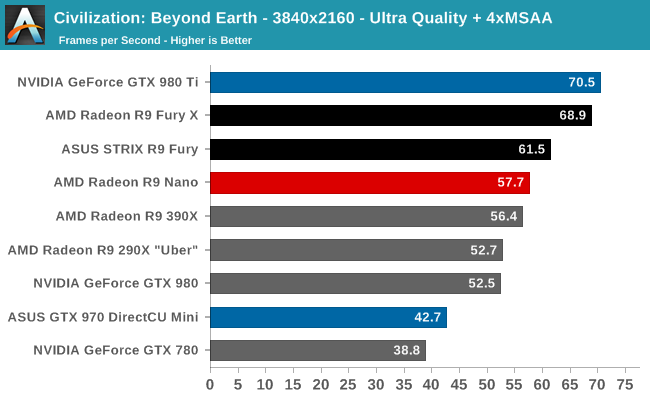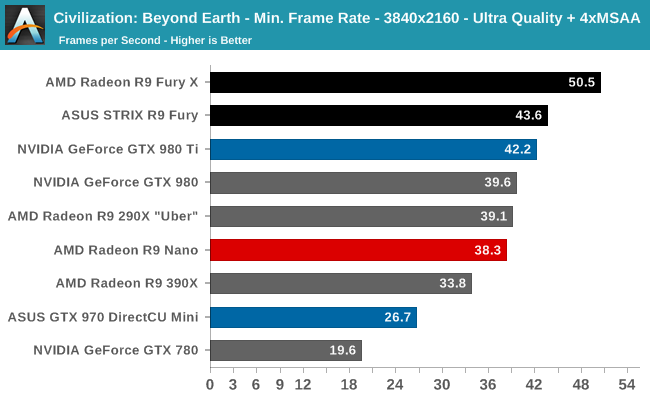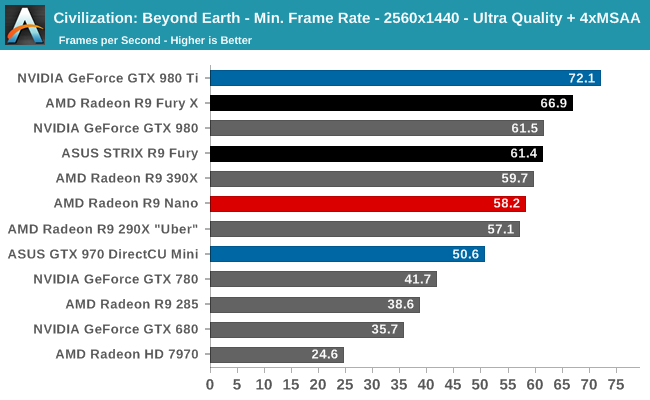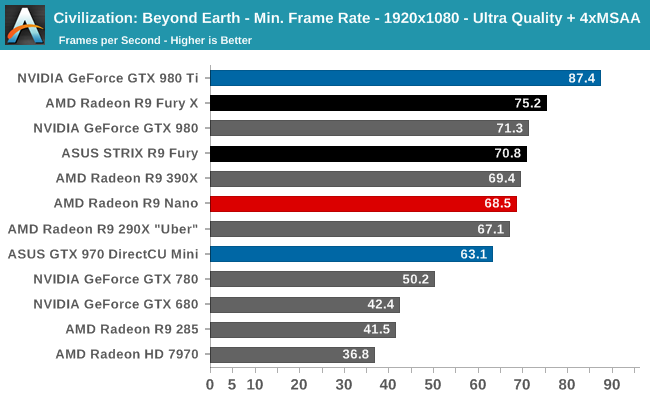The AMD Radeon R9 Nano Review: The Power of Size
by Ryan Smith on September 10, 2015 8:00 AM ESTCivilization: Beyond Earth
Shifting gears from action to strategy, we have Civilization: Beyond Earth, the latest in the Civilization series of strategy games. Civilization is not quite as GPU-demanding as some of our action games, but at Ultra quality it can still pose a challenge for even high-end video cards. Meanwhile as the first Mantle-enabled strategy title Civilization gives us an interesting look into low-level API performance on larger scale games, along with a look at developer Firaxis’s interesting use of split frame rendering with Mantle to reduce latency rather than improving framerates.



Not unlike Crysis 3, this is another game where the R9 Nano is on guard against NVIDIA thanks to the sub-Fury performance. Overall performance is still plenty, cracking 90fps at 2560x1440, but none the less it trails the power-similar GTX 980. The upside for AMD here is that for the size-similar GTX 970 Mini, the R9 Nano is still easily in the lead.



As for minimums, not unlike Shadow of Mordor, the R9 Nano is in a tough spot. Even with the advantage of Mantle, it always delivers slightly lower minimums than the GTX 980.










284 Comments
View All Comments
itproflorida - Friday, September 11, 2015 - link
"As these benchmarks are from single player mode" haha,Kutark - Thursday, September 10, 2015 - link
I think *overall* AMD has a win with this as they've found a market (albeit small) that they can fill with a product without competition.This does lead me to wonder, what can Nvidia do? We know maxwell 2 is a little more power efficient than fiji... could they do a similar binning and back a GM200 chip down a 100mhz or so at a 175w tdp and produce similar results in a similar sized package? I know the HBM makes it a bit easier for the small form factor, but i don't think people will cry over half an inch longer board for an nvidia card in the same market.
Peichen - Friday, September 11, 2015 - link
GTX980 is already a 175W card. Reference GTX980 have the same power plug requirement as the Nano.slapdashbr - Friday, September 11, 2015 - link
nVidia isn't pushing (as far as I know) any of it's AIB partners to do this, but: gigabyte could just make a gtx 980 on the same PCB as that 970 mini. The 980 only uses what, 165W? 180 maybe? it's roughly on par with the nano to be honest, and with the fairly low power draw I really don't see why you can't have a 980 on a shorter card. Honestly an ITX-size 980 was what I wanted as soon as they were announced, for god's sake, the r9-380 can draw more juice than a 980 and those are available in ITX form factor.Kutark - Friday, September 11, 2015 - link
Fair point. I still wonder though if they did a GM200, basically a 980ti thats backed down on clock rates to meet a lower TDP, what it would look like.medi03 - Saturday, September 12, 2015 - link
There is more to it: that HBM memory thing allows for more compact designs.extide - Monday, September 14, 2015 - link
Well yeah, but there are already ITX sized cards out there with GDDR5 (GTX 970, R9 380, etc) so it's obviously possible. PCB might be a little bit bigger but it can still be ITX sized.Kutark - Wednesday, September 30, 2015 - link
Not *that* much more compact. From what i understand we're talking about half an inch or so shorter because of the HBM.Jm09 - Thursday, September 10, 2015 - link
I wish amd would of released a nano and a nano-x with this choice being the nano x as its a binned full Fiji chip. I think an r9 nano competing in the $400 range would of been a huge hit, and raise brand perception which amd needs a ton of right now.Peichen - Friday, September 11, 2015 - link
Nano is the full chip. It just runs at a lower clock than Fiji X and Fiji, the actual trimmed card.